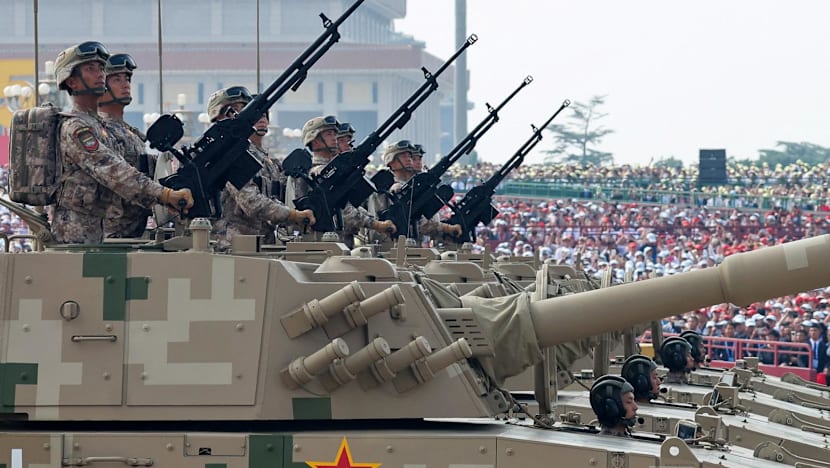Politics
China Showcases Advanced Weaponry in Military Parade Amid Taiwan Tensions

Beijing recently held a military parade to commemorate the 80th anniversary of China’s victory over Japan in World War II, showcasing advanced weaponry that emphasizes its focus on national defense and sovereignty. The event featured a range of new military hardware, highlighting China’s preparedness for potential operations concerning Taiwan, which it considers a part of its territory.
Analysts noted that while President Xi Jinping did not mention Taiwan during his speech, the display of military assets suggested a clear message regarding Beijing’s intentions. The People’s Liberation Army (PLA) organized the parade according to combat-readiness standards, which many see as a direct signal to Taiwan and the United States regarding military readiness and deterrence capabilities.
New Developments in Military Technology
Among the notable weapons on display was the new Type 100 tank, designed to enhance survivability against drone strikes. Military analyst Fu Qianshao explained that this medium-weight tank features an advanced active protection system, making it well-suited for operations in diverse terrains, including high-altitude and beach landings. This development indicates lessons learned from conflicts such as the war in Ukraine, where conventional tanks faced significant challenges.
The parade also introduced multiple unmanned ground vehicles and aerial drones. These systems, including reconnaissance-strike vehicles and anti-drone platforms, are expected to play a critical role in any future operations concerning Taiwan. Fu predicted that initial assaults would likely involve unmanned platforms leading the charge.
Additionally, the display included the PHL-16 rocket launcher, which analysts view as crucial for potential conflicts across the Taiwan Strait due to its long-range strike capabilities. This system parallels the American High Mobility Artillery Rocket System (HIMARS), which Taiwan has acquired. Such advancements highlight the growing military sophistication of the PLA as it approaches its centenary goal by 2027.
Strategic Messaging and Regional Implications
The military parade served not only as a show of force but also as a strategic message directed at both Taiwan and foreign powers. It included land-, sea-, and air-based nuclear missile capabilities, underscoring Beijing’s commitment to defending its sovereignty. State media described these capabilities as essential for safeguarding national dignity and deterring interference in China’s internal affairs, particularly regarding Taiwan and the South China Sea.
Military expert Wang Yunfei asserted that the showcased equipment could provide “formidable support” during amphibious assaults. Among the advanced systems were anti-ship missiles like the YJ-15, YJ-19, and YJ-20, designed for high-speed combat and rapid strikes against enemy vessels. The DF-26D missile, known for its ability to target both land and maritime objectives with a range of 5,000 kilometers, has been labeled the “Guam killer” due to its potential threat to US military assets.
The parade also featured China’s latest aircraft designed for carrier operations, including the J-15T and J-15DT, which reflect the advancements made in naval aviation. With the imminent deployment of the third aircraft carrier, the Fujian, these developments signal a shift in China’s military capabilities in the region.
As tensions continue to simmer over Taiwan, the military parade reinforced Beijing’s narrative of a strong defensive posture. Commentators, including military analyst Song Zhongping, emphasized that the primary objective is to achieve victory without resorting to arms, using displays of military strength to deter pro-independence sentiments in Taiwan.
In summary, the recent military parade in Beijing highlighted China’s ongoing commitment to national defense and its assertive stance regarding Taiwan. By showcasing advanced weaponry and military technologies, Beijing has sent a clear message about its readiness to protect its sovereignty in an increasingly complex geopolitical landscape.
-

 Lifestyle4 months ago
Lifestyle4 months agoHumanism Camp Engages 250 Youths in Summer Fest 2025
-

 Business5 months ago
Business5 months agoKenvue Dismisses CEO Thibaut Mongon as Strategic Review Advances
-

 Sports4 months ago
Sports4 months agoDe Minaur Triumphs at Washington Open After Thrilling Comeback
-

 Sports5 months ago
Sports5 months agoTupou and Daugunu Join First Nations Squad for Lions Clash
-

 Top Stories5 months ago
Top Stories5 months agoColombian Senator Miguel Uribe Shows Signs of Recovery After Attack
-

 World5 months ago
World5 months agoASEAN Gears Up for Historic Joint Meeting of Foreign and Economic Ministers
-

 Health4 months ago
Health4 months agoNew Study Challenges Assumptions About Aging and Inflammation
-

 Business5 months ago
Business5 months agoOil Prices Surge Following New EU Sanctions on Russia
-

 Entertainment4 months ago
Entertainment4 months agoDetaşe-Sabah Violin Ensemble Captivates at Gabala Music Festival
-

 Entertainment4 months ago
Entertainment4 months agoBaku Metro Extends Hours for Justin Timberlake Concert
-

 Top Stories5 months ago
Top Stories5 months agoRethinking Singapore’s F&B Regulations Amid Business Closures
-

 Business5 months ago
Business5 months agoU.S. House Approves Stablecoin Bill, Sends to Trump for Signature









